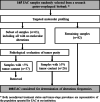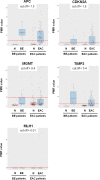Targeted genetic and epigenetic profiling of esophageal adenocarcinomas and non-dysplastic Barrett's esophagus
- PMID: 35701814
- PMCID: PMC9195284
- DOI: 10.1186/s13148-022-01287-7
Targeted genetic and epigenetic profiling of esophageal adenocarcinomas and non-dysplastic Barrett's esophagus
Abstract
Background: Despite the efforts to describe the molecular landscape of esophageal adenocarcinoma (EAC) and its precursor lesion Barrett's esophagus (BE), discrepant findings are reported. Here, we investigated the prevalence of selected genetic (TP53 mutations and microsatellite instability (MSI) status) and epigenetic (DNA promoter hypermethylation of APC, CDKN2A, MGMT, TIMP3 and MLH1) modifications in a series of 19 non-dysplastic BE and 145 EAC samples. Additional biopsies from adjacent normal tissue were also evaluated. State-of-the-art methodologies and well-defined scoring criteria were applied in all molecular analyses.
Results: Overall, we confirmed frequent TP53 mutations among EAC (28%) in contrast to BE, which harbored no mutations. We demonstrated that MSI and MLH1 promoter hypermethylation are rare events, both in EAC and in BE. Our findings further support that APC, CDKN2A, MGMT and TIMP3 promoter hypermethylation is frequently seen in both lesions (21-89%), as well as in a subset of adjacent normal samples (up to 12%).
Conclusions: Our study further enlightens the molecular background of BE and EAC. To the best of our knowledge, this is one of the largest studies addressing a targeted analysis of genetic and epigenetic modifications simultaneously across a combined series of non-dysplastic BE and EAC samples.
Keywords: Barrett’s esophagus; DNA methylation; Esophageal adenocarcinoma; Microsatellite instability; TP53 mutations.
© 2022. The Author(s).
Conflict of interest statement
The authors declare that they have no competing interests.
Figures





Similar articles
-
Inactivation of p16, RUNX3, and HPP1 occurs early in Barrett's-associated neoplastic progression and predicts progression risk.Oncogene. 2005 Jun 9;24(25):4138-48. doi: 10.1038/sj.onc.1208598. Oncogene. 2005. PMID: 15824739
-
Hypermethylation of the AKAP12 promoter is a biomarker of Barrett's-associated esophageal neoplastic progression.Cancer Epidemiol Biomarkers Prev. 2008 Jan;17(1):111-7. doi: 10.1158/1055-9965.EPI-07-0407. Cancer Epidemiol Biomarkers Prev. 2008. PMID: 18199717
-
Identification of Subtypes of Barrett's Esophagus and Esophageal Adenocarcinoma Based on DNA Methylation Profiles and Integration of Transcriptome and Genome Data.Gastroenterology. 2020 May;158(6):1682-1697.e1. doi: 10.1053/j.gastro.2020.01.044. Epub 2020 Feb 4. Gastroenterology. 2020. PMID: 32032585 Free PMC article.
-
Role of epigenetic alterations in the pathogenesis of Barrett's esophagus and esophageal adenocarcinoma.Int J Clin Exp Pathol. 2012;5(5):382-96. Epub 2012 May 23. Int J Clin Exp Pathol. 2012. PMID: 22808291 Free PMC article. Review.
-
Genetic and Epigenetic Alterations in Barrett's Esophagus and Esophageal Adenocarcinoma.Gastroenterol Clin North Am. 2015 Jun;44(2):473-89. doi: 10.1016/j.gtc.2015.02.015. Epub 2015 Apr 1. Gastroenterol Clin North Am. 2015. PMID: 26021206 Free PMC article. Review.
Cited by
-
Epigenetic Alterations from Barrett's Esophagus to Esophageal Adenocarcinoma.Int J Mol Sci. 2023 Apr 25;24(9):7817. doi: 10.3390/ijms24097817. Int J Mol Sci. 2023. PMID: 37175524 Free PMC article. Review.
-
Current Challenges of Methylation-Based Liquid Biopsies in Cancer Diagnostics.Cancers (Basel). 2024 May 24;16(11):2001. doi: 10.3390/cancers16112001. Cancers (Basel). 2024. PMID: 38893121 Free PMC article. Review.
-
EsoDetect: computational validation and algorithm development of a novel diagnostic and prognostic tool for dysplasia in Barrett's esophagus.PeerJ. 2025 Jul 3;13:e19613. doi: 10.7717/peerj.19613. eCollection 2025. PeerJ. 2025. PMID: 40620772 Free PMC article.
-
Spatiotemporal Study of a Risk-Stratification Epigenetic-Based Biomarker Assay in Patients With Barrett Esophagus.Am J Gastroenterol. 2025 Feb 12;120(6):1285-1295. doi: 10.14309/ajg.0000000000003367. Am J Gastroenterol. 2025. PMID: 39933887 Free PMC article.
-
Epigenetic reprogramming in gastrointestinal cancer: biology and translational perspectives.MedComm (2020). 2024 Aug 24;5(9):e670. doi: 10.1002/mco2.670. eCollection 2024 Sep. MedComm (2020). 2024. PMID: 39184862 Free PMC article. Review.
References
-
- Desai TK, Krishnan K, Samala N, Singh J, Cluley J, Perla S, et al. The incidence of oesophageal adenocarcinoma in non-dysplastic Barrett's oesophagus: a meta-analysis. Gut. 2012;61(7):970–976. - PubMed
Publication types
MeSH terms
Supplementary concepts
LinkOut - more resources
Full Text Sources
Medical
Research Materials
Miscellaneous

